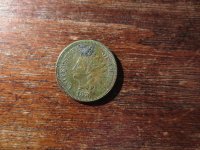acedigger
Sr. Member
Paper money unfair to blind - court
Federal appeals court says Treasury Department is violating the law by keeping dollars the same size and feel.
EMAIL | PRINT | DIGG | RSS Subscribe to Top Stories
feed://rss.cnn.com/rss/money_topstories.rss
Paste this link into your favorite RSS desktop reader
See all CNNMoney.com RSS FEEDS (close) By Jessica Dickler, CNNMoney.com staff writer
Last Updated: May 20, 2008: 1:55 PM EDT
NEW YORK (CNNMoney.com) -- A federal appeals court ruled Tuesday that the U.S. Treasury Department is violating the law by failing to design and issue currency that is readily distinguishable to blind and visually impaired people.
The U.S. Court of Appeals for the District of Columbia Circuit upheld a 2006 district court ruling that could force the United States to redesign its money so blind people can distinguish between values.
Suggested solutions include making bills different sizes, including raised markings or using foil printing which is a method of hot stamping that is tactically discernable.
Judge Judith Rogers, in a ruling on a suit by the American Council of the Blind, wrote that the Treasury Department's failure to design and issue paper currency that is readily distinguishable to the visually impaired violates the Rehabilitation Act's guarantee of "meaningful access."
The Rehabilitation Act of 1973 was originally designed to extend civil rights to disabled individuals and provide them a full opportunity to participate in American society.
Rogers also wrote that Treasury Secretary Henry Paulson has not met his burden to show why changing the money would impose an undue burden.
"A large majority of other currency systems have accommodated the visually impaired, and the Secretary does not explain why U.S. currency should be any different," Rogers wrote in her ruling.
The euro, for example, is one currency designed to be more readily identifiable. Each banknote has a predominant color and large numbers to make them easier to see. Also, the larger the denomination of the euro, the larger the banknote.
"We are very pleased with the ruling," said a spokeswoman for the American Council of the Blind. "We are hopeful that the Treasury Department will now get busy and come up with a plan to make paper money more readily identifiable for the visually impaired people all over the world."
The Treasury Department was not immediately available for comment.
The suit was originally filed in 2002 by the American Council of the Blind and two individuals with visual impairments, Patrick Sheehan and Otis Stephens.
The appeals court ruled 2-1, with Judge A. Raymond Randolph dissenting. Judge Thomas Griffith joined Rogers in voting to uphold the lower court ruling.
First Published: May 20, 2008: 11:37 AM EDT
Federal appeals court says Treasury Department is violating the law by keeping dollars the same size and feel.
EMAIL | PRINT | DIGG | RSS Subscribe to Top Stories
feed://rss.cnn.com/rss/money_topstories.rss
Paste this link into your favorite RSS desktop reader
See all CNNMoney.com RSS FEEDS (close) By Jessica Dickler, CNNMoney.com staff writer
Last Updated: May 20, 2008: 1:55 PM EDT
NEW YORK (CNNMoney.com) -- A federal appeals court ruled Tuesday that the U.S. Treasury Department is violating the law by failing to design and issue currency that is readily distinguishable to blind and visually impaired people.
The U.S. Court of Appeals for the District of Columbia Circuit upheld a 2006 district court ruling that could force the United States to redesign its money so blind people can distinguish between values.
Suggested solutions include making bills different sizes, including raised markings or using foil printing which is a method of hot stamping that is tactically discernable.
Judge Judith Rogers, in a ruling on a suit by the American Council of the Blind, wrote that the Treasury Department's failure to design and issue paper currency that is readily distinguishable to the visually impaired violates the Rehabilitation Act's guarantee of "meaningful access."
The Rehabilitation Act of 1973 was originally designed to extend civil rights to disabled individuals and provide them a full opportunity to participate in American society.
Rogers also wrote that Treasury Secretary Henry Paulson has not met his burden to show why changing the money would impose an undue burden.
"A large majority of other currency systems have accommodated the visually impaired, and the Secretary does not explain why U.S. currency should be any different," Rogers wrote in her ruling.
The euro, for example, is one currency designed to be more readily identifiable. Each banknote has a predominant color and large numbers to make them easier to see. Also, the larger the denomination of the euro, the larger the banknote.
"We are very pleased with the ruling," said a spokeswoman for the American Council of the Blind. "We are hopeful that the Treasury Department will now get busy and come up with a plan to make paper money more readily identifiable for the visually impaired people all over the world."
The Treasury Department was not immediately available for comment.
The suit was originally filed in 2002 by the American Council of the Blind and two individuals with visual impairments, Patrick Sheehan and Otis Stephens.
The appeals court ruled 2-1, with Judge A. Raymond Randolph dissenting. Judge Thomas Griffith joined Rogers in voting to uphold the lower court ruling.
First Published: May 20, 2008: 11:37 AM EDT






